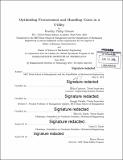Optimizing procurement and handling costs in a utility
Author(s)
Genser, Bradley Philip
DownloadFull printable version (6.384Mb)
Other Contributors
Leaders for Global Operations Program.
Advisor
Bruce Cameron and Georgia Perakis.
Terms of use
Metadata
Show full item recordAbstract
We propose a novel method to quantify the cost of activities involved in the picking portion of order fulfillment. We adapt the general method of picking cost quantification to the specific situation of TP&G, a publicly held utility, to build a simulation model which calculates total cost (procurement purchasing costs + material handling costs) across TP&G's Construction Materials Supply Chain (CMSC) . We use the simulation model to demonstrate the effect of case pack quantities and various disputed (within TP&G) material handling policies on supply chain costs. Finally. we move beyond the descriptive results of the simulation model and build optimization models for a case where a single case pack quantity is held in inventory, under conditions of both deterministic and stochastic demand. We show that case pack quantity held in inventory greatly impacts supply chain costs. We also find the novel result that the optimal material picking policy for both deterministic and stochastic demand is a threshold policy whereby orders should be fulfilled with whole case packs up to the highest possible multiple of case pack quantity that does not exceed an ordered quantity. If the remainder of an order to be fulfilled exceeds a certain number of units in a case pack, that remainder should be fulfilled with a whole case pack (overfilled). This threshold can be efficiently calculated for all case pack quantities (optimal or not).
Description
Thesis: M.B.A., Massachusetts Institute of Technology, Sloan School of Management, 2014. In conjunction with the Leaders for Global Operations Program at MIT. Thesis: S.M., Massachusetts Institute of Technology, Department of Mechanical Engineering, 2014. In conjunction with the Leaders for Global Operations Program at MIT. 10 Cataloged from PDF version of thesis. Includes bibliographical references (page 111).
Date issued
2014Department
Leaders for Global Operations Program at MIT; Massachusetts Institute of Technology. Department of Mechanical Engineering; Sloan School of ManagementPublisher
Massachusetts Institute of Technology
Keywords
Sloan School of Management., Mechanical Engineering., Leaders for Global Operations Program.